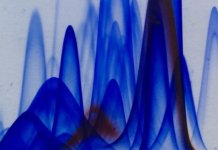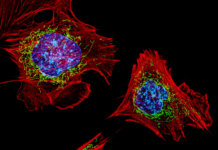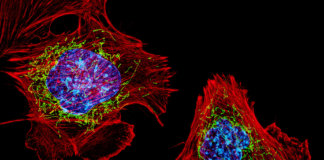1001 ways to stress a cell
Stress: oxidative, hypoxic, thermic, chemical, osmotic, inonizing, genotoxic… so many ways to stress a cell, and the list goes on! When our bodies are facing these triggers, our cells only have two options: adapt, or die.
By “adapting”, we refer to the many mechanisms that respond to stress. For instance, when a cell is stretched (as it is during a physical effort), it can modify its cyto-skeleton, the structure maintaining its anatomy, in order to avoid tearing and to later come back to its initial shape. In the case of pathological stress, such as exposure to toxic chemicals, the cell can also increase its capacity to deal with waste as a response. These adaptation processes can even go much further, and modify the expression of a protein, DNA structure or even the metabolism of the cell.
When the cell goes into overdrive, however, it can no longer adapt to face the stress it is subjected to. The cell then enters apoptosis, programmed cell death, the ultimate recourse to those attacks.

For the past 10 years, the study of cellular stress has become a subject of great importance in the research circles, in terms of pathology and aging alike.
Oxidative stress has become a major subject of interest, especially regarding cardiovascular and neurodegenerative diseases, as well as cancer occurrence ; those are diseases largely tied to aging and to our cells’ capacity to handle stress.
What targets for cellular stress?
Stress can take up many forms and target many organelles: the nucleus (where lies our genetic information, our DNA), the mitochondria (powerhouse of the cell), and the endoplasmic reticulum (where proteins are synthesized) are privileged targets. However, peroxysomes (that modify in part lipids and amino-acids, and synthesize oxygen-reactive species) can also be targeted.
In this series of articles, we will attempt to understand how cellular stress works, how it manifests itself, what tools cells and organelles can use to fight back. We will also look into potential answers as to how to prevent stress, and the role it plays in the aging process. What a plan!
All our articles on Cellular stress and aging:
Cellular stress and aging, a necessary duo?
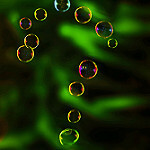 Although it is recognized as a risk factor by the scientific community, many questions remain regarding cellular stress. Its main role in aging-related diseases and in aging itself is still being studied.
Although it is recognized as a risk factor by the scientific community, many questions remain regarding cellular stress. Its main role in aging-related diseases and in aging itself is still being studied.
Part 1: The different types of cellular stress
 Cellular stress can mean many different mechanisms, whether the stress is mechanical, toxic, chemical, thermic, osmotic, ionizing… They all play a role in the aging process of our cells.
Cellular stress can mean many different mechanisms, whether the stress is mechanical, toxic, chemical, thermic, osmotic, ionizing… They all play a role in the aging process of our cells.
Part 2: The organelles targeted by cellular stress
 Cellular stress gets transmitted through several organelles in our cells, especially those of the mitochondria, the mitochondria and the nucleus, among others. Their response can vary and only give the cell under stress two viable options: adapt and survive, or die.
Cellular stress gets transmitted through several organelles in our cells, especially those of the mitochondria, the mitochondria and the nucleus, among others. Their response can vary and only give the cell under stress two viable options: adapt and survive, or die.
Part 3: Dealing with cellular stress
 In order to slow down the aging process of our cells, we must control our cellular stress. In this article, we will look into the techniques and/or treatments currently used to treat all forms of cellular stress.
In order to slow down the aging process of our cells, we must control our cellular stress. In this article, we will look into the techniques and/or treatments currently used to treat all forms of cellular stress.
Dr. Marion Tible

Author/Reviewer
Auteure/Relectrice
Marion Tible has a PhD in cellular biology and physiopathology. Formerly a researcher in thematics varying from cardiology to neurodegenerative diseases, she is now part of Long Long Life team and is involved in scientific writing and anti-aging research.
More about the Long Long Life team
Marion Tible est docteur en biologie cellulaire et physiopathologie. Ancienne chercheuse dans des thématiques oscillant de la cardiologie aux maladies neurodégénératives, elle est aujourd’hui impliquée au sein de Long Long Life pour la rédaction scientifique et la recherche contre le vieillissement.
En savoir plus sur l’équipe de Long Long Life
Dr Guilhem Velvé Casquillas
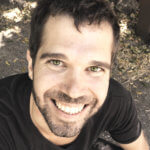
Author/Reviewer
Auteur/Relecteur
Physics PhD, CEO NBIC Valley, CEO Long Long Life, CEO Elvesys Microfluidic Innovation Center
More about the Long Long Life team
Docteur en physique, CEO NBIC Valley, CEO Long Long Life, CEO Elvesys Microfluidic Innovation Center
En savoir plus sur l’équipe de Long Long Life



![[Video] Eurosymposium on Healthy Ageing, Brussels, 2018 Eurosymposium on Healthy Aging](http://www.longlonglife.org/wp-content/uploads/2019/07/P1310252-218x150.jpg)





